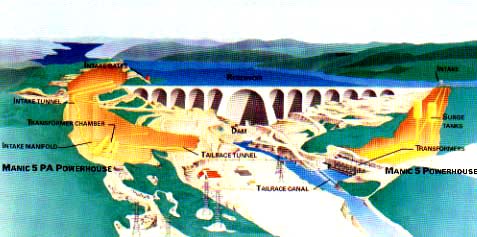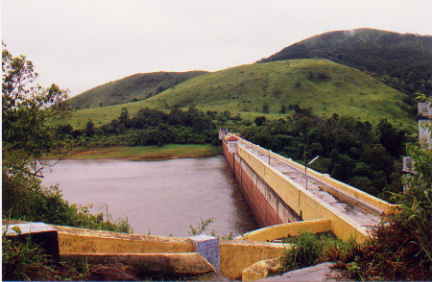.

|
Roy Mathew, Special Correspondent, The Hindu, Trivandrum |
Paper presented at the workshop on 'Kerala and Inter-State River Water Agreements' jointly organised by the Indian Society of Interdisciplinary Studies and the Press Club, Trivandrum on March 23, 1997 at the Press Club Hall in Trivandrum, Kerala, India.
The technical aspects of dam safety is a subject that should be handled by experts. This paper attempts only an overview of the subject and interpretation of the information available on the safety aspects of Mullaperiyar, Idukki, Kulamavu and Cheruthoni dams, the latter three forming the Idukki reservoir of the Idukki Project in Kerala (India). Some of the material I am discussing here was collected during the Comparative Study of Hydroelectric Projects in Canada and India undertaken by me on a media fellowship from the Shastri Indo-Canadian Institute.
Before going into the specifics of the situation at Mullaperiyar,
let
us examine some of the factors associated with dam safety.
Dam safety depends on five factors:*
In the 20th century, around 200 notable dam failures have occurred in the World, killing about 8000 people. It is notable that dam failures do occur in developed countries too. The biggest catastrophe recorded in this century had occurred in Vaiont in Italy in 1963. The accident killed about 2600 people. Another accident of nearer proportions occurred in India in 1979-- about 2000 persons lost their lives when the Machhu II dam gave way. Other dam failures in the country included Ashti in Maharastra (this dam gave way twice-- in 1883 and 1933), Tigra in Madhya Pradesh (1970), Panchat (1961), Kadakwasala (1961), Nanak Sagar (1967) and Chikkahole (1972). The failure of the Malpasset dam in France in 1959 killed 421 persons and the Baffalo Creek dam in USA in 1972 claimed 125 lives.

Hence, it is imperative that measures are taken to replace the dam. In 1979, Kerala, Tamil Nadu and the Central Water Commission came to an agreement that the maximum reservoir level should be kept low at 136 feet and additional spillways should be constructed to avoid the risk of water level rising in the reservoir. It is notable that Tamil Nadu has not completed the construction of spillways even after 17 years. The spillway capacity is very important from the point of dam safety for as many as 50 per cent of dam failures in the World1 had resulted from inadequate capacity of the spillways. Tamil Nadu not only neglected this aspect, but also took certain measures that further jeopardised the dam’s safety. (I am not forgetting that it took some measures to strengthen the foundation of the dam.). It allowed excavated materials to be dumped upstream of the spillways, that too to the level of the spillways.
The expert committee appointed by the Government has reported that the loose earth dumped on the upstream side of the spillway crust would flow over the crust and ogee and might damage the concrete surface. This report was made some time ago. Now plants have started growing over the dumped material. While this may reduce the amount of loose earth that may overflow, it creates the additional risk of debris getting trapped on them and finally blocking the spillway at least partially. In any case, the presence of the dump above the spillway is bound to affect spillway efficiency, which would be crucial in case of a heavy monsoon. If the spillways, including the additional ones proposed, are not fully functional, that would increase the risk to the dam.
I discuss Idukki dams in more detail here because condition of the Mullaperiyar dam has a direct bearing on the safety of the dams of the Idukki Project. The level of risk arising from a dam is a function of probability of the dam failure and its consequences. Taken individually, the probability of a dam failure is very high in case of Mullaperiyar and low in case of Idukki. However, the consequences are relatively low in case of Mullaperiyar and very high in case of Idukki. Taken together, the risk level is on the high side both in terms of probability and consequences.
Many have come to think that an arch dam is safer than a concrete gravity dam. This is not true. A gravity dam, as the name implies, holds the water because of its sheer weight. On the other hand, the arch dam holds the water because of its design features. Hence, any damage to the structure of dam is more serious in the case of an arch dam. For the same reason an arch dam requires better monitoring.
Mr. Phong Nguyen, heading the Dam Safety and Maintenance wing of
Hydro
Quebec2,
Canada,
told me in an interview that in case of arch dams, the foundations come
under great stress. This was because of the to and fro movement of the
arch when water fills and empties the reservoir. The arch can withstand
this movement and pressure eminently. But that is not the case with the
foundation where the arch ends. The foundation develops problems
because
of the stress resulting from this movement.
He noted that he Manic-5 multiple arch dam3
in Quebec is facing serious problems such as bulging cracks in the dam.
Hydro Quebec was spending two to three million dollars a year to
monitor
the dam. It had also spent millions of dollars for grouting and other
repair
work. Arch dams, he said, were very difficult to monitor and very
expensive
to repair.
Incidentally, about 87 per cent of dam failures involving concrete dams are reported to have occurred because of foundation failure. In the case of arch dams, the risk of a foundation failure is on the higher side as indicated by Mr. Nguyen.
The Idukki arch dam, at the time of construction, was equipped to monitor even the slightest movement of the dam body and changes in stress. But almost all of the 16 systems which were set up for this purpose are now either malfunctioning or inoperative. The remaining systems are being used sparingly to monitor the dam. Consequently, no data is available after 1990 on the condition of the dam from a safety point of view. This is a serious situation.
I am not detailing the possible consequences of failure of either Mullaperiyar or Idukki to avoid a scare. But it is telling commentary on the Kerala State Electricity Board (KSEB) that it is not properly monitoring the biggest dam in the State on which much of the State’s prosperity and lives of thousands of people living downstream depends. I am also refraining from talking about emergency action plans as it is pointless to speak about such costly plans when the KSEB is not caring about even monitoring of the dam’s condition. I conclude quoting Nguyen: “Risks increase in the absence of proper maintenance and surveillance.”

Sundaraiya, E., Kalsi, R. K., (Dam Safety Organisation, Central Water Commission, New Delhi) Dam Safety Activities in India, paper presented at the International Seminar on Dam Safety in Thiruvananthapuram, Kerala, India, 1996.
Sasidharan, M., Dam Safety Monitoring of Dams with particular
reference
to Idukki Arch Dam, Paper presented at the Institution of Engineers,
Thiruvananthapuram,
Kerala, India, 1997.
| Muallaperiyar:
Dam Safety Issues
Paper No. II Related: Dam Rehabilitation and Improvement Project |
| Roy's Home Page
Titile
Contents
Study on Hydroelectric Projects
Resource Planning
Great Whale Project Sources of Information Niagara Falls Generators Photo Folio Biodata |